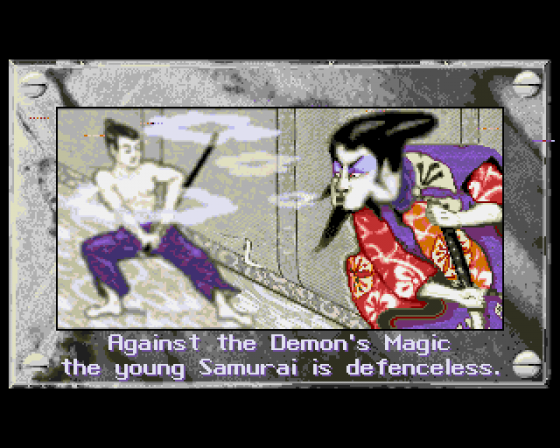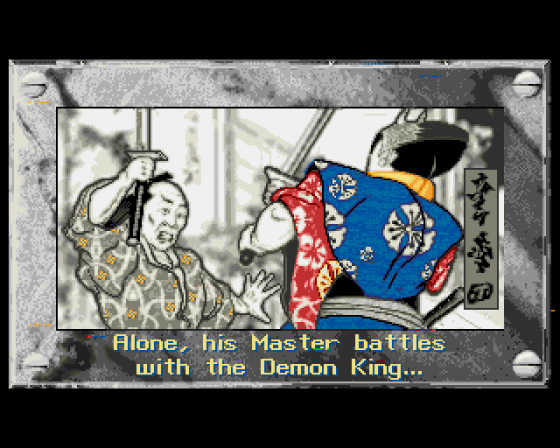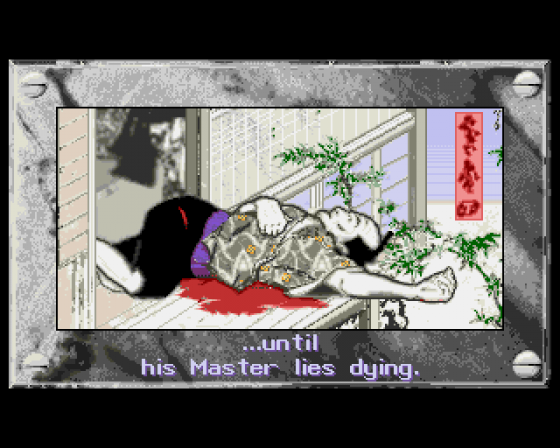
The One
 1st December 1990
1st December 1990
Categories: Preview: Software
Author: Kati Hamza
Published in The One #27
Kati Hamza is rewarded with samurai execution.
First Samurai (Image Works)
"I was watching Them! on TV," explains VID's graphic artist, Dokk, "when I just started talking about samurai. At the time we were in the middle of designing another game but we weren't very happy with it. That's when it hit us."
From random thoughts, great designs emerge. When Dokk sat down with Mev Dinc and John Twiddy - head honchos of Vivid Image Development, creators of The Last Ninja (8-bit), Hammerfist and Time Machine - in the company's Watford office, they decided the samurai concept was exactly what they were looking for.
"We wanted something fairly mystical so that we could put in lots of special effects. Samurai also have a very strong sense of honour - that fitted in with our plot."

And honour is what it's all about. For you, a highly trained samurai bodyguard, the murder of your ancient Japanese lord is the ultimate disgrace. Under normal circumstances immediate hara kiri would be the only honourable way out, but this crime is different. The moustache twiddling perpetrator is no ordinary Japanese villain but a megalomaniac demon who laughs in the face of goodness, tweaks the nose of respectability and makes his escape by warping through time. Before the body was cold, you snatched up your magic sword and swore on your master's beard to travel into the future, battle through four death-defying levels, and sort out that double-crossing demon.
They called it The First Samurai (the 'pun' on The Last Ninja, by the way, is purely coincidental!) and as Dokk (whose previous work includes Vendetta, Dominator and BMX Kidz) began designing the graphics, Vivid Image discussed who should program it. That's where Raffaele Cacco came in.
"I'd just converted Time Machine for Vivid Image on the Spectrum and Amstrad and they asked me would I do this. I was looking for a 16-bit project to do at the time but everybody kept offering me 8-bit stuff because I'd done so much of it before. Then I saw Dokk's graphic sequences and thought, "I'll have some of those".

The admiration was mutual. Mev Dinc: "We wanted Raf to do it because he's not only a very good programmer, he also comes up with lots of really good ideas. If I suggest one thing, he usually comes back with three."
Development so far has been an ongoing creative process in which everyone is encouraged to participate. "Deciding on sprites and backgrounds that everybody is happy with can be time-consuming. We don't argue, we just have constructive discussions."
What they don't need to discuss is their determination to make The First Samurai a tad more special than your average hack 'n slay romp. User-friendly controls are a top priority: "You have to be able to pick up the joystick and just play the game." The First Samurai comes with a variety of different fighting movements but there's no need to sit down and learn them before you play.

As John Twiddy explains, "The main thing is to get lots of manoeuvres in there. They're all effective so ultimately you don't actually need to know how you've done each one."
There's no need to sacrifice visual impact to easy-to-handle controls: "In some arcade games, when your opponent's in a certain position you end up grabbing them and throwing them over your shoulder. It looks you're doing something very spectacular but in fact it's the computer showing standard joystick moves in different ways on screen. That's a feature we'd like to include."
The First Samurai definitely won't be one of those games that restricts you to walking in one direction. The aim is to get you experimenting, leaping about and exploring your environment, so there's a plethora of rocks to climb on, platforms to jump off and ledges to land on. One option under discussion involves more complex search and map factors on Level Three.

Three sub-games are included for variety's sake. As you are whizzed into the future on some form of fast-moving transport, a train, or a lift for example, you leap from point to point, negotiate traps and avoid treacherous obstacles (as yet unknown).
Another major VID innovation is a direct trade-off between kicking ass and watching your back. Approaching the demon's tower, your rudimentary knowledge of magic is boosted by power-ups. The simplest way to exploit the is to charge up your magic sword or release your karma in the form of a fireball.
The strategic alternative involves charging up a transportation pad further along your route. Next time you die, there's no need to fight your way through familiar enemies again - you restart from that spot.

Though Raf's CV consists of a list of Spectrum and Amstrad titles as long as your arm (Equinox, Exolon, Cybernoid, Stormlord, Solomon's Key) The First Samurai is his first project on 16-bit, specifically the Amiga. Inevitably, most of the two months in which he's been involved in the project been taken up with getting used to the machine: "Obviously I couldn't use any old sprite handling or scrolling routines because I didn't have any. I've had to start everything from scratch."
There's plenty of time for him to get the hang of it: The First Samurai isn't due to be released for another nine months. VID deliberately opted for a fairly long development period: "We want to make certain there's plenty of time at the end for tweaking. This is the sort of game where it all comes down to how many enemies there are and where they're positioned." The final version will have had all its levels extensively tested one by one.
Meanwhile, VID has various other projects up its sleeve, though what, how and why is something the team's not prepared to reveal at this delicate stage of negotiation. Some dabbling with a 16-bit console (We're not sure which one!) may also be on the horizon, though nothing's settled yet. As for Raf, it doesn't look like he's going back to the Spectrum: "I'm enjoying 16-bit too much."






